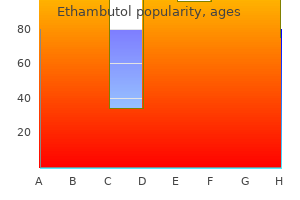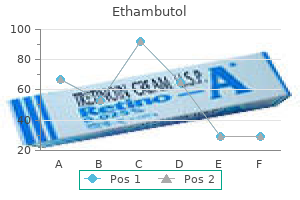"Order 800mg ethambutol amex, antimicrobial zinc".
By: A. Varek, M.A., Ph.D.
Assistant Professor, Hackensack Meridian School of Medicine at Seton Hall University
In order to protect the kidney from losing its perfusion due to this vasoconstriction antibiotics jeopardy 600 mg ethambutol otc, the kidney simultaneously releases prostaglandins at both the afferent and efferent arterioles antibiotics for uti kidney infection 400mg ethambutol mastercard, where they act as vasodilators antibiotic mechanism of action purchase generic ethambutol pills. The macula densa is a specialized portion of the thick ascending limb adjacent to the hilus of the glomerulus infection 6 weeks after surgery purchase generic ethambutol. This patient has nephropathy, as evidenced by the lower-extremity swelling (as a result of hypoalbuminemia), hyperlipidemia, and proteinuria. Initially this serves to preserve glomerular filtration rate and kidney function in the face of hypertension, but over time, hyperfiltration injury to the glomerulus, in addition to hyperglycemic injury (this patient clearly has suboptimal glucose control) to the glomerulus by non-enzymatic glycosylation, led to the development of nephritic disease. Blockade of b1-receptors leads to the inhibition of sympathetic stimulation of heart rate, then to a slower heart rate and decreased cardiac muscle contractility. Amlodipine is a calcium channel blocker that is used often as firstline antihypertensive therapy. Inhibition of calcium channels leads to decreased ability of vascular smooth muscle to contract, leading to less vasoconstriction and lower blood pressure. Furosemide is a loop diuretic that acts by inhibiting sodium reabsorption in the loop of Henle. Hydrochlorothiazide is a thiazide diuretic that works by inhibiting sodium reabsorption in the distal convoluted tubule. Rapidly progressive glomerulonephritis is characterized by the presence of crescents in most glomeruli. The description of this patient indicates that many glomeruli are spared, making this syndrome unlikely. IgA nephropathy (Berger disease) is characterized by the presence of prominent IgA, not IgM, deposits in the mesangial region of the glomerulus. As it causes the nephritic syndrome, mild proteinuria usually is present, and hematuria usually is found. Although membranous glomerulonephritis is the most common cause of nephrotic syndrome, it is characterized by diffuse thickening of capillary walls and deposits of IgG in the glomerular basement membrane. Minimal change disease is the most common cause of the nephrotic syndrome in children. It usually responds well to corticosteroids, however, and appears normal on light microscopy. Increased sodium intake leads to volume expansion and increased stretch in mechanoreceptors located in the afferent arteriole. The mechanoreceptor response to increased plasma volume is decreased renin secretion, which causes vasodilation of glomerular afferent arterioles. Atrial natriuretic peptide is secreted by the atria in response to increased extracellular fluid volume and causes dilation of the glomerular afferent arterioles. However, this is a physiologic response by cells in the atria of the heart to high sodium intake and volume expansion, not a response intrinsic to the kidney. Increased delivery of sodium and water to the macula densa would lead to a decrease in renin release from the juxtaglomerular apparatus, as renin would otherwise lead to aldosterone release and further sodium retention. Increased plasma sodium and water leads to increased sodium chloride delivery to the macula densa, leading to the suppression (not the increase) of renin release by the juxtaglomerular apparatus. Decreased renin levels lead to decreased aldosterone, which would result in increased potassium reuptake, not potassium wasting. High sodium intake leads to volume expansion, dilation of afferent arterioles, and increased stretch in baroreceptors, which leads to decreased renin release. This clinical presentation is classic for benign prostatic hyperplasia obstructing the urethra and causing bilateral hydronephrosis (seen on ultrasound as dilation of the collecting ducts), thereby leading to renal failure. Renal failure can be divided into prerenal (due to lack of perfusion of the kidney), intrinsic renal (due to acute tubular necrosis from ischemia or toxins), and postrenal (due to obstruction of outflow). Each type of renal failure has distinct characteristics, allowing differentiation by urinalysis. In postrenal failure, the kidneys are unable to effectively concentrate the urine, so the urine osmolality would be <350 mmol/kg. Epithelial casts are seen in acute tubular necrosis, a cause of intrinsic renal failure. A FeNa <1% would be expected in prerenal failure, where the kidney is working to reabsorb as much sodium as possible to increase plasma volume and thereby improve perfusion. In postrenal failure, the kidney is unable to effectively reabsorb sodium, and therefore the FeNa would commonly be >4%.
In pregnancies with prior cesarean sections antibiotics with alcohol buy cheapest ethambutol, the scar is ideally assessed by transvaginal ultrasound virus yardville 600mg ethambutol. Furthermore antibiotic for kidney infection cheap ethambutol 400mg with mastercard, implantation of the gestational sac in the cesarean scar (cesarean scar implantation) is of significant importance given its association with placenta accreta and serious pregnancy complications bacterial overgrowth purchase ethambutol with paypal. Note that the placenta (P) is a previa in this pregnancy as it is shown to cover the internal cervical os (asterisk). The presence of placenta previa in the first trimester is of little clinical significance and should be followed up in the second trimester of pregnancy. Any significant discrepancy in biometric measurements should alert for the possible presence of anatomic abnormalities or genetic malformations. First trimester fetal biometry and pregnancy dating are discussed in detail in Chapter 4. Comprehensive Assessment of Fetal Anatomy the comprehensive assessment of fetal anatomy is an important component of the detailed first trimester ultrasound. This approach to fetal anatomy in early gestation involves multiple sagittal, axial, and coronal planes of the fetus. Acquiring the technical skills required for the display of the corresponding anatomic planes and an in-depth knowledge of the current literature on this subject are prerequisites for the performance of the detailed first trimester ultrasound examination. In this section, we present our systematic approach to the assessment of fetal anatomy in the detailed first trimester ultrasound examination. General Anatomic Assessment the initial step of the fetal anatomy survey in the first trimester involves obtaining an anterior midsagittal plane of the fetus when technically feasible. This midsagittal plane allows for a general anatomic assessment, given that the whole fetus is commonly included in this plane. This midsagittal plane displays several important anatomic landmarks, which are listed in Table 5. In this midsagittal plane, the size and proportions of the fetal head, chest, and body are subjectively assessed and the following anatomic regions are recognized: fetal facial profile and midline intracranial structures, the anterior abdominal wall, the fetal stomach, and bladder. By slightly tilting the transducer from the midline to the left and right parasagittal planes, the arms and legs can be visualized. Many of the severe fetal malformations that can be detected in the first trimester (Table 5. When clinically indicated, color and pulsed Doppler interrogation of the ductus venosus is also best assessed in this midsagittal plane. The Fetal Head and Neck Evaluation of the anatomy of the fetal head and neck in the first trimester requires imaging from the midsagittal, axial, and coronal planes. Normal anatomic features of the midsagittal plane of the head and neck are shown in Figure 5. Abnormalities that can be detected in this plane include anencephaly, holoprosencephaly, anterior cephalocele, proboscis, absent nasal bone, maxillary gap or protrusion (associated with cleft palate), epignathus, retrognathia, and others. Abnormalities that can be detected in the midsagittal plane of the facial profile are described and illustrated in Chapter 9. Abnormalities that can be detected by the midsagittal plane of the posterior fossa are presented and illustrated in Chapter 8. No structure protruding Nose present and nasal bone ossified No maxillary gap, no protrusion Upper and lower lips appear normal Normal appearance, no retrognathia In coronal plane, eyes seen with the nose between In coronal plane, no cleft and normal mandibular gap Axial Planes From the midsagittal plane, the transducer is rotated 90 degrees to get the axial planes of the fetal head, ideally imaged from the lateral aspects. These planes include the axial plane at the level of the lateral ventricles, the axial plane at the level of the thalami, the axial-oblique plane at the level of the cerebellum and posterior fossa, and the axial plane at the level of the orbits. Normal anatomic features of these four axial planes of the fetal head are shown in Figures 5. The choroid plexuses are often asymmetrical and touch the lateral and medial borders of the ventricles and their area is between 50% and 75% of the areas of the ventricles. In this plane, the hourglass shape of the fourth ventricle and its choroid plexus is best visualized along with the developing cisterna magna. Abnormalities that can be detected by these axial planes of the fetal head include anencephaly, holoprosencephaly, ventriculomegaly, encephalocele, open spina bifida, and some severe eyes and face anomalies as described and illustrated in Chapters 8 and 9. The (plane 2) aqueduct is not choroid plexus of fourth ventricle, hourglass Visualized with stuck to the occipital bone Fourth ventricle (plane 3) shape Eyes (plane 4) In anterior axial planes, two orbits with eyes are visualized with the nose arising between Some details are better seen on transvaginal ultrasound. Planes 1 and 2 are obtained from fetuses at 13 weeks of gestation and examined by the transabdominal linear probe.

Immunization options were shown in the previous section antimicrobial jackets buy generic ethambutol online, so we will not discuss that issue here again virus quarantine meaning purchase cheap ethambutol on-line. They can proliferate indefinitely in vitro and usually do not produce antibodies virus 1980 imdb order ethambutol line. Usually antibiotic impregnated cement purchase ethambutol online from canada, splenocytes and myeloma cells are used in a ratio ranging from 1:1 to 10:1. After the fusion, cells are grown in a selective medium in which only the hybridomas are able to survive. After 10 to 15 days of fusion, cells are screened for the production of specific antibodies. The screening has to be performed by a rapid method, capable to detect as low as nanograms per milliliter or micrograms per milliliter of antibody and to allow the selection of cells producing antibodies with the desired characteristics. Once specific hybridomas have been selected, they are cloned by limit dilution or in semisolid agar, and clones are frozen until they are used. Selected monoclonal antibodies can be produced in vivo by producing ascitic fluid in mice (generally 2 to 20 mg/ml of antibody can be recovered), or in vitro, by growing hybridomas in bioreactors (allows the production of gramto-kilogram quantities of antibody) (44). Antibodies can be purified by chromatographic procedures from the supernatant of hybridoma cultures or from ascitic fluid. In the first case, antigen is usually covalently bound to inert beads, which are then mixed with the antibody solution. After the specific binding of antibodies to the antigen, the unbound substances in the sample are removed by washing. The beads are then treated with an elution buffer, and the purified antibody is released. There are several elution reagents, such as ionic detergents, dissociating agents, chaotropic agents, organic solvents, high salt buffers, or high or low pH buffers. Notwithstanding, the systems using proteins A or G are frequently the most recommended techniques. In general, protein A is recommended for mouse monoclonal antibodies from the IgG2a, IgG2b, and IgG3 subclasses, whereas protein G is used for purifying IgG1. There are problems associated with the use of fluorochrome, such as over- or underlabeling. Therefore, for each antibody there is an optimal ratio of fluorochromes to antibody. For labeling antibodies with the isothiocyanate derivatives of these fluorochromes, the antibody solution should not contain additional molecules with free amino groups (45). Add 50 l of fluorochrome solution per milliliter of antibody solution very slowly. The ratio of fluorochrome to protein can be estimated by measuring the absorbance at 495 nm and 280 nm for fluorescein, or 575 nm and 280 nm for rhodamine. The biotin groups can act as binding groups for avidin or strepavidin, which are commercially available, coupled to enzymes, fluorochromes, or iodine. The affinity of biotin for avidin or streptavidin is exceptionally high (Ka 1015 liter mol-1); thus, the interaction is essentially irreversible and can be used as an amplification system to reveal antigen-antibody reactions (45). The technique for the covalent coupling of biotin to antibodies is very simple and normally does not have any adverse effect on the antibody. Add the biotin ester to the antibody at a ratio of 25 to 100 g of ester to 1 mg of antibody. Incubate with ammonium chloride solution (20 ml of 1 M per 250 mg of ester) for 10 min at room temperature. The latter is commonly used for conjugation of peroxidase to IgG immunoglobulins and allows the binding of up to 90% of the enzyme.

A tumor is classified as rectosigmoid when differentiation between rectum and sigmoid 4 according to the previously mentioned guidelines is not possible antibiotic eye drops discount generic ethambutol uk. Anteriorly virus in michigan buy ethambutol 600mg visa, the peritoneal reflection is located at the junction of middle and lower third of the rectum 10 antimicrobial agents cheap ethambutol 600 mg with mastercard, while laterally bacteria 3d quality ethambutol 600mg, it is located at the junction of upper and middle third of the rectum. Posteriorly, the reflection is located higher and most of the posterior rectum does not have a serosal covering. Conservative options like transanal disc excisions are often considered for location "below the anterior peritoneal reflection. If information about tumor location with respect to the peritoneal reflection is included in the report, the aspect of rectum in question (posterior, lateral, anterior) should also be noted. Medullary carcinoma may occur either 9-11 sporadically or in association with Lynch syndrome. This tumor type is characterized by solid growth in nested, organoid, or trabecular patterns, with no immunohistochemical evidence of neuroendocrine differentiation. Medullary carcinomas are also characterized by numerous tumor infiltrating lymphocytes and a better prognosis. Micropapillary carcinoma is characterized by small, tight clusters of tumor cells in cleft-like spaces, and is often present in association with conventional adenocarcinoma. This variant is strongly associated with lymphovascular 12 invasion and lymph node metastasis. Serrated adenocarcinomas are characterized by neoplastic glands showing prominent serrations, tumor cells with basal nuclei and eosinophilic cytoplasm, and no or minimal luminal necrosis. These tumors are thought to be related to traditional serrated adenomas and may have a more aggressive course than conventional 13 adenocarcinoma. Histologic Grade A number of grading systems for colorectal cancer have been suggested, but a single widely accepted and uniformly used standard for grading is lacking. Most systems stratify tumors into 3 or 4 grades as follows: Grade 1 Grade 2 Grade 3 Grade 4 Well differentiated (>95% gland formation) Moderately differentiated (50-95% gland formation) Poorly differentiated (<50% gland formation) Undifferentiated (no gland formation or mucin; no squamous or neuroendocrine differentiation) 14 Despite a significant degree of interobserver variability histologic grade has been shown to be an important 15,16 17 with strong correlation between poor differentiation and adverse outcome. Pathologists should use the four-tier histologic grading scheme as specified above to prevent errors in data recording. This grading scheme is also not applicable to poorly differentiated neuroendocrine carcinomas. Carcinoma in an Adenomatous Polyp: Microscopic Tumor Extension and High-Risk Features Colorectal adenomas containing invasive adenocarcinoma that extends through the muscularis mucosa into the 14 submucosa have been defined as malignant polyps. This term encompasses cases in which the entire polyp head is replaced by carcinoma and adenomas with focal malignancy, but the definition excludes adenomas with high-grade dysplasia or intramucosal carcinoma (invasive carcinoma limited to the lamina propria or invading no deeper than the muscularis mucosa), because these polyps possess negligible biological potential for metastasis (see this in Note M). Malignant polyps removed by endoscopic polypectomy require evaluation of histologic factors related to the risk of adverse outcome (ie, lymph node metastasis or local recurrence from residual malignancy) following 18-20 Factors shown to have independent prognostic significance and are important in determining the polypectomy. Submucosal involvement has been divided into superficial, mid and 21 deep levels for sessile polyps (Kikuchi levels sm1, sm2 and sm3) for sessile polyps, and into four levels (head, 22 neck, stalk and beyond stalk) in pedunculated polyps (Haggitt levels). Based on measurement, submucosal 20 invasion more than 1mm has been recognized as an adverse prognostic factor. However, it can be difficult to accurately assess the depth or extent of submucosal involvement due to improper orientation and absence of muscularis propria in these specimens. Lymph-Vascular and Perineural Invasion It is recommended that small vessel vascular invasion should be reported separately from venous (large vessel) invasion. Small vessel invasion indicates tumor involvement of thin-walled structures lined by endothelium, without an identifiable smooth muscle layer or elastic lamina. Small vessel invasion is associated with lymph node metastasis and has been shown to be 23,24 the higher prognostic significance of extramural independent indicator of adverse outcome in several studies. Tumor involving endothelium-lined spaces with an identifiable smooth muscle layer or elastic lamina is considered venous (large vessel) invasion. Circumscribed tumor nodules surrounded by an elastic lamina on hematoxylineosin (H&E) or elastic stain are also considered venous invasion. Venous invasion can be extramural (beyond muscularis propria) or intramural (submucosa or muscularis propria). Extramural venous invasion has been demonstrated by multivariate analysis to be an independent adverse prognostic factor in multiple studies and is a 25 risk factor for liver metastasis. Histologic features like tumor deposits adjacent to arterioles ("orphan arteriole" sign) and elongated tumor nodules extending into 26 pericolic fat from the muscularis propria ("protruding tongue" sign) can raise the suspicion for venous invasion.

The urogenital folds make up the ventral shaft of the penis and penile urethra in the male antibiotic resistance scientific journal cheap ethambutol online amex. This patient suffers from the autosomal recessive disorder alkaptonuria infection attack 14 discount ethambutol 800mg overnight delivery, a deficiency in homogentisic acid oxidase virus 68 in michigan proven 400mg ethambutol. As a result of the deficiency bacteria fermentation order ethambutol online from canada, there is an accumulation of alkapton bodies (homogentisic acid) in urine and cartilage. The lack of homogentisic oxidase blocks the metabolism of phenylalanine-tyrosine at the level of homogentisic acid. The homogentisic acid accumulates and a large amount is excreted, imparting a black color to the urine if allowed to stand and undergo oxidation. Affected patients are usually asymptomatic in childhood other than the change in urine color upon standing. In adulthood, the build-up of pigment in cartilage and its calcification can cause arthritic changes. By an unknown mechanism, the pigment causes the cartilage to lose its resiliency and become brittle and fibrillated. The arthropathy develops slowly and usually does not manifest until the patient is >30 years old. A deficiency of branched-chain a-ketoacid dehydrogenase would result in maple syrup urine disease, an inability to break down branched-chain amino acids. Refsum disease is a deficiency of phytanic acid oxidase and is characterized by an inability to break down branched-chain fatty acids. This deficiency results in albinism because patients are unable to make melanin, a derivative of tyrosine. This type of mutation is one of those found in the thalassemia picture, as described in this patient. In contrast, Mycoplasma pneumoniae infection typically yields a hemolytic anemia in which IgM antibodies are directed at the I (upper case) antigen. This disorder is a hypoproliferative anemia in which an appropriate reticulocytosis, as seen in this patient, is absent. Warm hemolytic anemia is associated with autoimmune disease, lymphoproliferative disorders, and drug abuse. Symptomatic primary infection is mostly seen in the elderly, children, and immunocompromised individuals. A caseating granuloma is formed in which necrotic tissue and bacteria are surrounded by macrophages and giant cells. The patient is suffering from Hashimoto thyroiditis, an autoimmune disorder that is a common cause of hypothyroidism. Other classic signs and symptoms of hypothyroidism include cold intolerance, hypoactivity, weakness, diminished reflexes, dry and cool skin, and coarse hair. Antimicrosomal antibodies, also called antithyroid peroxidase antibodies, are associated with Hashimoto thyroiditis. This is a typical clinical picture of Rett syndrome, a rare pervasive developmental disorder nearly always affecting girls 4 years old or younger. The hallmark features include decelerating social, cognitive, and verbal development that slowly progress to degeneration in these areas. Children become mentally retarded, expressionless, and nonverbal over the course of several years. Although language and social degeneration occurs in patients with Rett syndrome, gross hearing is unaffected. Hyperactivity is not associated with Rett syndrome; in fact, children with Rett syndrome are typically withdrawn, apathetic, and solemn. Tics are characteristic of Tourette syndrome, which typically begins in childhood. The image shows hypersegmented neutrophils, which are commonly seen in megaloblastic anemia. By an unknown mechanism, phenytoin blocks absorption of folate and increases utilization of folate by the body, leading to folic acid deficiency. While vitamin B12 deficiency can cause a megaloblastic anemia, phenytoin is not a cause of vitamin B12 deficiency. The most likely explanation for her laboratory results is agranulocytosis, an adverse effect of clozapine use.
Cheap generic ethambutol uk. Interpreting the Results of the Bauer Kirby Method of Antibiotic Susceptibility Testing.



